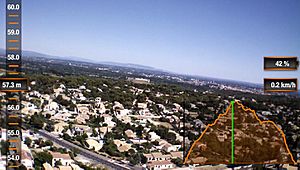Parrot AR.Drone facts for kids
Parrot AR.Drone is a discontinued remote controlled flying quadcopter built by the French company Parrot. The drone is designed to be controlled by mobile or tablet operating systems such as the supported iOS or Android within their respective apps or the unofficial software available for Windows Phone, Samsung BADA and Symbian devices.
Applications
- AR.Drone
Previously known as AR.Freeflight, provides piloting function for AR.Drones, and the ability to take photos and videos. AR.Drone was launched in 2010 alongside the original drone, and provides piloting capabilities via iOS devices. It allows pilots to record video or capture images from their drone's onboard cameras. When originally launched pilots could control drones by tilting their device, and data from the onboard accelerometer was converted into flight controls. On-screen controls provide joystick-style movement, and other functions that allow pilots to perform aerobatics, play games, or update their drone's firmware. The app also integrates with AR.Drone Academy, where pilots can map and share flight details with other AR.Drone users. AR.Drone is available on the Google Play store, where it has kept the name AR.Freeflight.
- AR.Race 2 (previously AR.Race)
AR.Race is a piloting and multiplayer gaming application for the AR.Drone 2.0. Using a target included with the drone, pilots can define a race course with a start and finish line. The drone will then detect when it crosses this line, and records the flight time in between these two events. Pilots may invite other AR.Drones to join the race, and scores are aggregated into a leaderboard. The application also integrates with AR.Drone Academy and, when the AR.Freeflight application was removed from the iOS App Store, was updated to include basic piloting controls. AR.Race 2, and its predecessor AR.Race are only available on for iOS devices.
- AR.Rescue 2 (previously AR.Rescue)
A single-player augmented reality application for iOS devices. It uses the target provided with the AR.Drone 2.0 to build a 3D environment in which pilots must perform various tasks. The object of the game is to construct a rocket out of pieces that are placed into the physical environment by the drone's software. Along with these pieces, enemies are generated that must be fought. The drone also records the time it takes to complete this task successfully, and this is recorded in AR.Drone Academy, where a global leaderboard is generated, and videos and images can be shared amongst the community.
- AR.Hunter
An augmented, multiplayer game that allows pilots to engage a human target with virtual weapons within a 3D space. Unlike the other multiplayer games made by Parrot, AR.Hunter only requires one AR.Drone. Both the pilot and the 'target' have the application installed on iOS devices, and the 'target' uses theirs to fire their virtual weapons at the drone. In order for the drone to recognise and engage the 'target', they must wear a colored cap, purchased separately from Parrot. The game can be played without the cap, but the drone is unable to engage the 'target', and the pilot must instead evade detection or attack. AR.Hunter is not compatible with the AR.Drone 2.0.
Third party uses
To aid third-party developers, Parrot launched the AR.Drone open API game development platform. Due to this open platform, affordability, and wide range of onboard sensory equipment, the AR.Drone is becoming an increasingly popular tool in research and education. It has been used for experiments with visual-based autonomous navigation, autonomous surveillance, and human-machine interaction. Research in these areas has resulted in third-party applications being released, some open source, that extend the official capabilities of the drone.
In France, the AR.Drone 2.0 was tested by a Special Operations unit for aerial reconnaissance, whilst other companies have been developing software that allows the drone to track sports activities, and generate training feedback. An AR.Drone was used by Tim Pool during the Occupy Wall Street protest, running modified software that allowed it to stream directly to an internet channel. He theorised that a chain of command could be set up, where multiple people could step up and take control should the primary operator be detained by police. To further this, he began development of a new control system, replacing the existing Wi-Fi hotspot with a 3G chip. This would allow users to control drones via the internet, and potentially from remote locations.
An open source framework "Yet another drone", developed by students at University of Hamburg will allow programmers to easily build applications for AR Drone in Java.
Images for kids
See also
 In Spanish: Parrot AR.Drone para niños
In Spanish: Parrot AR.Drone para niños







